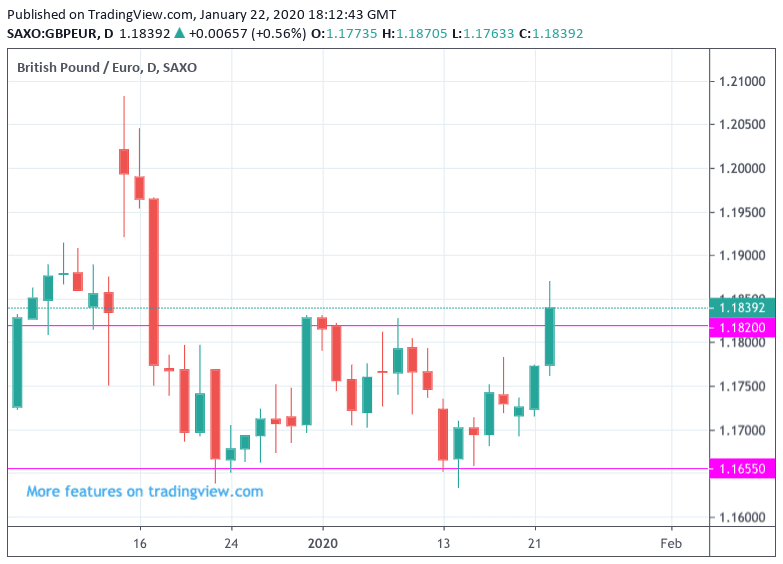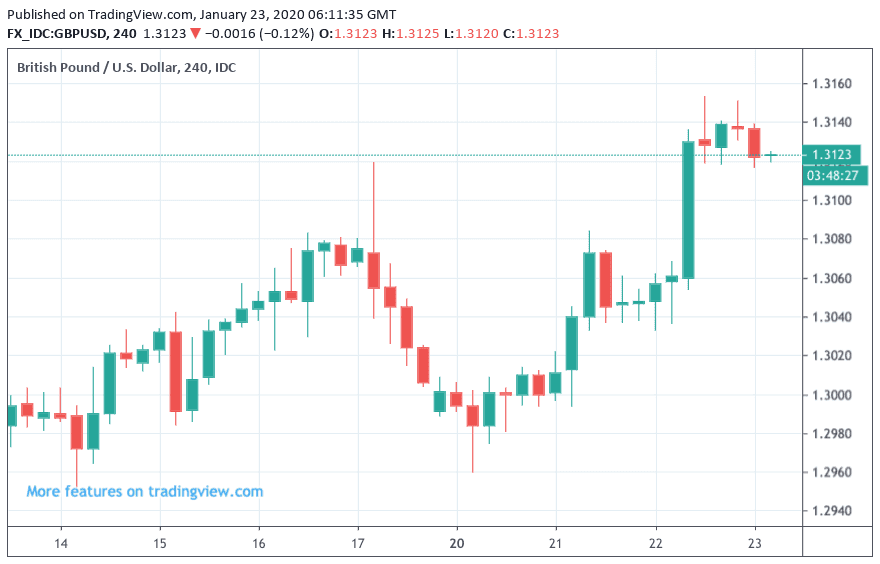Pound Sterling Clears Big Levels Against the Euro and Dollar as January's Turnaround Extends
- Pound can go higher say chart analysts
- Gains come as UK data improves
- However, disappointing PMIs on Friday will reverse the rally

Image © Adobe Images
- Spot rates at time of writing: GBP/EUR: 1.0808, -1.75% | GBP/USD: 1.1852, -2.15%
- Bank transfer rates (indicative): GBP/EUR: 1.0520-1.0596 | GBP/USD: 1.1537-1.1620
- Specialist money transfer rates (indicative): GBP/EUR 1.0650-1.0701 | GBP/USD: 1.1650-1.1745 >> More details
The British Pound has extended its short-term rally over the course of the past 24 hours, and in the process broken above 1.18 in GBP/EUR and above 1.31 in GBP/USD, thanks to further signs of growing economic optimism in the UK. However, the higher Sterling goes, the further it has to fall on Friday if the highly anticipated flash PMIs disappoint.
Sterling was the best performing major currency on Wednesday, January 23 after the CBI Industrial Trends survey showed a surge in business optimism in the wake of the December General Election. The CBI's quarterly Business Optimism survey read at +23 vs. -44 previously, which makes for a sizeable leap.
"The monthly survey does not usually generate much interest, let alone much movement, but this one caught investors' imagination. It showed a major swing from pessimism to optimism; the biggest since the survey began in 1958," says Lee McDarby, analyst at MoneyCorp.
This uptick in optimism confirms the findings of the Deloitte CFO survey out earlier this month which reported an "unprecedented rise in business sentiment" following the General Election in December.
As a result, the market's pricing for a January 30 interest rate cut at the Bank of England fell from 65% to below 50% as it becomes clear the UK economy might not need the support offered by lower interest rates, and Sterling rallied in tandem. The rule-of-thumb in currency markets is that when a central bank cuts interest rates, the currency it issues falls, and vice versa. Therefore, fading expectations for a rate cut at the Bank of England are likely to boost demand for the currency.
"The 'reversal' in rate cut expectations/interest rate support, triggered a new upleg of Sterling," says Mathias Van der Jeugt, an analyst with KBC Markets in Brussels, who notes the GBP/EUR exchange rate is testing the 1.1834 resistance level on the charts.
Van der Jeugt says a break above this area would push the pair out of thea short-term consolidation range that has trapped the exchange rate for some time now, "and improve the short-term technical picture for Sterling."
Matt Weller, Global Head of Market Research at GAIN Capital says Sterling strength has pushed GBP/EUR above the tight 1.1655-1.1820 consolidation range, and the exchange rate has risen to test its highest levels of the year to date near 1.1848.
From a technical perspective, Weller says there’s potential for more Sterling upside towards 1.19 or even 1.20480.
Turning to the Pound-Dollar exchange rate, "Sterling is ripping the face off new short positions," says Erik Bregar, Head of FX Strategy at Exchange Bank of Canada. "All those shorts that came in following the slip below 1.3080-1.3100, over a week ago, appear to be scrambling to get out. GBP/USD has smashed up through the 1.3100 level and now looks poised to trade higher still."
Sterling Bulls Risk Overconfidence Heading into Friday's PMIs
While the Pound has pushed higher against the Euro and Dollar over recent days, the odds of a sharp reversal lower become all the more possible if the news flow surrounding the Pound turns negative.
We expect the issue of EU-UK trade negotiations to become the key theme for Sterling in 2020, however this is likely to be a story for coming months. Near-term direction remains centred around the Bank of England and economic data.
Markets will now turn their full attention to Friday's release of the flash PMI survey, that should give the first significant account of how the economy has evolved in the post-election period. Members of the Bank of England's interest rate setting council have this month indicated that their decision on whether or not to vote for an interest rate cut at the January 30 meeting will depend on the outcome of this survey.
The move higher in Sterling, and the corresponding decline in expectations for a Bank of England interest rate cut, betray a market that has become confident the PMI survey will show a comfortable jump in business activity.
If the data disappoints however, expectations for an interest rate cut will likely shoot higher once more, pressuring Sterling lower in the process.
The obvious risk is that the CBI industrial trends survey, which boosted Sterling midweek, has given the markets an overconfidence heading into Friday's PMI release; the market impact of any disappointment has therefore grown.
Indeed, Sterling could still fall even were the numbers to meet expectations, as foreign exchange markets are often prone to displaying 'buy the rumour, sell the fact' tendencies.
So while this week has been good for those holding the Pound, the risks for disappointment heading into the weekend have also risen.






